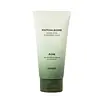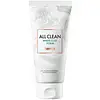What's inside
What's inside
 Key Ingredients
Key Ingredients

 Benefits
Benefits

 Concerns
Concerns

 Ingredients Side-by-side
Ingredients Side-by-side

Water
Skin ConditioningGlycerin
HumectantSodium Cocoyl Glycinate
CleansingSodium Cocoyl Glutamate
CleansingSodium Methyl Cocoyl Taurate
Cleansing1,2-Hexanediol
Skin ConditioningCitric Acid
BufferingPotassium Cocoyl Glycinate
Sodium Chloride
MaskingGlyceryl Stearate
EmollientSalicylic Acid
MaskingCamellia Sinensis Leaf Extract
AntimicrobialCitrus Nobilis Peel Extract
MaskingButylene Glycol
HumectantGardenia Florida Fruit Extract
Skin ConditioningCupressus Sempervirens Leaf/Stem Extract
Skin ConditioningCitrus Aurantium Bergamia Fruit Oil
MaskingHedera Helix Leaf/Stem Extract
AntimicrobialLitsea Cubeba Fruit Oil
MaskingRibes Nigrum Leaf Extract
PerfumingLactobacillus Ferment
Skin ConditioningCentella Asiatica Extract
CleansingPolygonum Cuspidatum Root Extract
AntioxidantScutellaria Baicalensis Root Extract
AstringentTheobroma Cacao Seed Extract
AntioxidantSaccharomyces Ferment
Skin ConditioningGlycyrrhiza Glabra Root Extract
BleachingDextrin
AbsorbentChamomilla Recutita Flower Extract
MaskingRosmarinus Officinalis Leaf Extract
AntimicrobialLactobacillus Ferment Lysate
Skin ConditioningMentha Suaveolens Leaf Extract
AstringentTaraxacum Officinale Leaf Extract
Skin ConditioningThymus Vulgaris Extract
PerfumingEthylhexylglycerin
Skin ConditioningWater, Glycerin, Sodium Cocoyl Glycinate, Sodium Cocoyl Glutamate, Sodium Methyl Cocoyl Taurate, 1,2-Hexanediol, Citric Acid, Potassium Cocoyl Glycinate, Sodium Chloride, Glyceryl Stearate, Salicylic Acid, Camellia Sinensis Leaf Extract, Citrus Nobilis Peel Extract, Butylene Glycol, Gardenia Florida Fruit Extract, Cupressus Sempervirens Leaf/Stem Extract, Citrus Aurantium Bergamia Fruit Oil, Hedera Helix Leaf/Stem Extract, Litsea Cubeba Fruit Oil, Ribes Nigrum Leaf Extract, Lactobacillus Ferment, Centella Asiatica Extract, Polygonum Cuspidatum Root Extract, Scutellaria Baicalensis Root Extract, Theobroma Cacao Seed Extract, Saccharomyces Ferment, Glycyrrhiza Glabra Root Extract, Dextrin, Chamomilla Recutita Flower Extract, Rosmarinus Officinalis Leaf Extract, Lactobacillus Ferment Lysate, Mentha Suaveolens Leaf Extract, Taraxacum Officinale Leaf Extract, Thymus Vulgaris Extract, Ethylhexylglycerin
Water
Skin ConditioningGlycerin
HumectantStearic Acid
CleansingMyristic Acid
CleansingPEG-32
HumectantPotassium Hydroxide
BufferingLauric Acid
CleansingBentonite
AbsorbentPotassium Cocoate
EmulsifyingButylene Glycol
HumectantCocamidopropyl Betaine
CleansingPotassium Cocoyl Glycinate
Glyceryl Stearate
EmollientPEG-100 Stearate
Kaolin
AbrasiveCitrus Aurantium Dulcis Peel Oil
MaskingLavandula Angustifolia Oil
MaskingAmyris Balsamifera Bark Oil
MaskingPelargonium Graveolens Flower Oil
MaskingCocos Nucifera Oil
MaskingCitrus Paradisi Peel Oil
MaskingLitsea Cubeba Fruit Oil
MaskingEucalyptus Globulus Leaf Oil
PerfumingMelaleuca Alternifolia Leaf Oil
AntioxidantMentha Arvensis Leaf Oil
MaskingBoswellia Carterii Oil
MaskingCitrus Aurantium Bergamia Fruit Oil
MaskingJuniperus Mexicana Oil
MaskingMyristica Fragrans Kernel Oil
MaskingTagetes Minuta Flower Oil
MaskingJasminum Officinale Flower/Leaf Extract
MaskingNelumbo Nucifera Flower Extract
Skin ConditioningFreesia Refracta Extract
Skin ConditioningIris Versicolor Extract
EmollientLeontopodium Alpinum Flower/Leaf Extract
Skin ConditioningLilium Candidum Bulb Extract
Skin ConditioningNarcissus Pseudo-Narcissus Flower Extract
Skin ConditioningRose Extract
Skin ConditioningPEG-75
HumectantPolyquaternium-7
Hyaluronic Acid
HumectantHydrolyzed Hyaluronic Acid
HumectantSodium Hyaluronate
HumectantEthylhexylglycerin
Skin ConditioningHydrolyzed Silk
HumectantDisodium EDTA
Sodium Benzoate
MaskingPhenoxyethanol
PreservativeParfum
MaskingWater, Glycerin, Stearic Acid, Myristic Acid, PEG-32, Potassium Hydroxide, Lauric Acid, Bentonite, Potassium Cocoate, Butylene Glycol, Cocamidopropyl Betaine, Potassium Cocoyl Glycinate, Glyceryl Stearate, PEG-100 Stearate, Kaolin, Citrus Aurantium Dulcis Peel Oil, Lavandula Angustifolia Oil, Amyris Balsamifera Bark Oil, Pelargonium Graveolens Flower Oil, Cocos Nucifera Oil, Citrus Paradisi Peel Oil, Litsea Cubeba Fruit Oil, Eucalyptus Globulus Leaf Oil, Melaleuca Alternifolia Leaf Oil, Mentha Arvensis Leaf Oil, Boswellia Carterii Oil, Citrus Aurantium Bergamia Fruit Oil, Juniperus Mexicana Oil, Myristica Fragrans Kernel Oil, Tagetes Minuta Flower Oil, Jasminum Officinale Flower/Leaf Extract, Nelumbo Nucifera Flower Extract, Freesia Refracta Extract, Iris Versicolor Extract, Leontopodium Alpinum Flower/Leaf Extract, Lilium Candidum Bulb Extract, Narcissus Pseudo-Narcissus Flower Extract, Rose Extract, PEG-75, Polyquaternium-7, Hyaluronic Acid, Hydrolyzed Hyaluronic Acid, Sodium Hyaluronate, Ethylhexylglycerin, Hydrolyzed Silk, Disodium EDTA, Sodium Benzoate, Phenoxyethanol, Parfum
 Reviews
Reviews

Ingredients Explained
These ingredients are found in both products.
Ingredients higher up in an ingredient list are typically present in a larger amount.
Butylene Glycol (or BG) is used within cosmetic products for a few different reasons:
Overall, Butylene Glycol is a safe and well-rounded ingredient that works well with other ingredients.
Though this ingredient works well with most skin types, some people with sensitive skin may experience a reaction such as allergic rashes, closed comedones, or itchiness.
Learn more about Butylene GlycolCitrus Aurantium Bergamia Fruit Oil is the oil from the bergamot orange. It is native to Italy.
This ingredient is used to add fragrance to products. It contains limonene, linalool, and linalyl acetate.
The term 'fragrance' is not regulated in many countries. In many cases, it is up to the brand to define this term. For instance, many brands choose to label themselves as "fragrance-free" because they are not using synthetic fragrances. However, their products may still contain ingredients such as essential oils that are considered a fragrance.
When used topically, Citrus Aurantium Bergamia Fruit Oil is a photosensitizer due to its furanocoumarins. Photosensitizers make the skin and eyes much more sensitive to sunlight. Photosensitizers are linked to skin cancer.
However, more cosmetics using Citrus Aurantium Bergamia Fruit Oil are removing the furanocoumarins.
Bergamot oil was also found to have anti-inflammatory, antibacterial and antifungal properties.
Learn more about Citrus Aurantium Bergamia Fruit OilEthylhexylglycerin (we can't pronounce this either) is commonly used as a preservative and skin softener. It is derived from glyceryl.
You might see Ethylhexylglycerin often paired with other preservatives such as phenoxyethanol. Ethylhexylglycerin has been found to increase the effectiveness of these other preservatives.
Glycerin is already naturally found in your skin. It helps moisturize and protect your skin.
A study from 2016 found glycerin to be more effective as a humectant than AHAs and hyaluronic acid.
As a humectant, it helps the skin stay hydrated by pulling moisture to your skin. The low molecular weight of glycerin allows it to pull moisture into the deeper layers of your skin.
Hydrated skin improves your skin barrier; Your skin barrier helps protect against irritants and bacteria.
Glycerin has also been found to have antimicrobial and antiviral properties. Due to these properties, glycerin is often used in wound and burn treatments.
In cosmetics, glycerin is usually derived from plants such as soybean or palm. However, it can also be sourced from animals, such as tallow or animal fat.
This ingredient is organic, colorless, odorless, and non-toxic.
Glycerin is the name for this ingredient in American English. British English uses Glycerol/Glycerine.
Learn more about GlycerinGlyceryl Stearate is a mix of glycerin and stearic acid.
It is used to stabilize the mixing of water and oil ingredients. By preventing these ingredients from separating, it can help elongate shelf life. It can also help thicken the product's texture.
As an emollient, it helps soften skin and supports barrier-replenishing ingredients.
In cosmetics, Glyceryl Stearate is often made from vegetable oils or synthetically produced.
This ingredient may not be fungal-acne safe
Fun fact: The human body also creates Glyceryl Stearate naturally.
Learn more about Glyceryl StearateLitsea Cubeba Fruit Oil is a fragrance and is an oil.
Potassium Cocoyl Glycinate is an amino acid-based surfactant and cleaning agent. This ingredient can be derived from animals or plants. It may also be synthetically created from fatty acids of the coconut and glycine.
Potassium Cocoyl Glycinate is a gentle surfactant. Surfactants help gather the dirt, oil, and other pollutants from your skin to be rinsed away. It is a mild cleanser and naturally produces foam.
Water. It's the most common cosmetic ingredient of all. You'll usually see it at the top of ingredient lists, meaning that it makes up the largest part of the product.
So why is it so popular? Water most often acts as a solvent - this means that it helps dissolve other ingredients into the formulation.
You'll also recognize water as that liquid we all need to stay alive. If you see this, drink a glass of water. Stay hydrated!
Learn more about Water